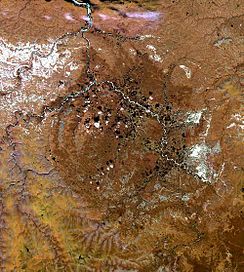Popigai-krater
| Popigai | ||

| ||
| Slagstruktuur | ||
| Sekerheid | Bevestig | |
| Deursnee | 90 km | |
| Voorwerp se deursnee | 5 ± 2 km | |
| Ouderdom | 35,7 ± 0,2 miljoen jaar Eoseen | |
| Boliedtipe | H-chondriet[1] | |
| Ontbloot | Ja | |
| Gebied | ||
| Land | ||
| Streek | Krasnojarsk-krai | |
| Ligging | ||
Die Popigai-krater in Siberië, Rusland, ding met die Manicouagan-krater in Kanada mee as die vierde grootste geverifieerde impakkrater op Aarde.[2] 'n Groot boliedbotsing het die 100 km breë krater sowat 35 miljoen jaar gelede tydens die Eoseen geskep.[3][4] Dit kan verband hou met die Eoseen-Oligoseen-uitwissing.[5]
Die krater is 300 km oos van die dorp Khatanga en 880 km noordoos van die stad Norilsk. Unesco het dit aangewys as 'n Geopark, 'n terrein van spesiale geologiese erfenis.[6] Daar is 'n klein moontlikheid dat die Popigai-krater saam met die sowat 35 miljoen jaar oue Chesapeake Bay-slagkrater gevorm het.[3]
Die terrein van die krater het paleontoloë en geoloë dekades lank betower, maar toegang tot die hele gebied was verbode weens diamante wat daar ontdek is. In 1997 is 'n groot ondersoekekspedisie daarheen gestuur, met 'n gevorderde begrip van die enigmatiese struktuur.[6] Die voorwerp wat die krater veroorsaak het, is geïdentifiseer as óf 'n 8 km breë chondriet óf 'n 5 km breë steenmeteoriet.
Die skok van die impak het grafiet in die grond binne 'n radius van 13,6 km van die punt van impak onmiddellik in diamante verander. Dié diamante is gewoonlik 0,5 tot 2 mm in deursnee, maar uitersonderlike spesimens is 10 mm breed.[6]
Verwysings
[wysig | wysig bron]- ↑ Schmitz, Birger; Boschi, Samuele; Cronholm, Anders; Heck, Philipp R.; Monechi, Simonetta; Montanari, Alessandro; Terfelt, Fredrik (2015). "Fragments of Late Eocene Earth-impacting asteroids linked to disturbance of asteroid belt". Earth and Planetary Science Letters. 425: 77–83. Bibcode:2015E&PSL.425...77S. doi:10.1016/j.epsl.2015.05.041. ISSN 0012-821X.
- ↑ Masaitis, Victor L. (2003). Popigai Crater: General Geology. Springer. pp. 81–85. ISBN 978-3-540-43517-4.
- ↑ 3,0 3,1 Deutsch, Alexander; Christian Koeberl (2006). "Establishing the link between the Chesapeake Bay impact structure and the North American tektite strewn field: The Sr-Nd isotopic evidence". Meteoritics & Planetary Science. 41 (5): 689–703. Bibcode:2006M&PS...41..689D. doi:10.1111/j.1945-5100.2006.tb00985.x.
- ↑ Armstrong, Richard; S. Vishnevsky; C. Koeberl (2003). U-Pb Analysis of zircons from the Popigai impact structure, Russia: First Results. Springer. pp. 99–116. ISBN 978-3-540-43517-4.
- ↑ "Russia's Popigai Meteor Crash Linked to Mass Extinction". 13 Junie 2014.
- ↑ 6,0 6,1 6,2 Deutsch, Alexander; V.L. Masaitis; F. Langenhorst; R.A.F. Grieve (2000). "Popigai, Siberia—well preserved giant impact structure, national treasury, and world's geological heritage". Episodes. 23 (1): 3–12. doi:10.18814/epiiugs/2000/v23i1/002.
Skakels
[wysig | wysig bron] Hierdie artikel is in sy geheel of gedeeltelik uit die Engelse Wikipedia vertaal.
Hierdie artikel is in sy geheel of gedeeltelik uit die Engelse Wikipedia vertaal.
Text is available under the CC BY-SA 4.0 license; additional terms may apply.
Images, videos and audio are available under their respective licenses.

